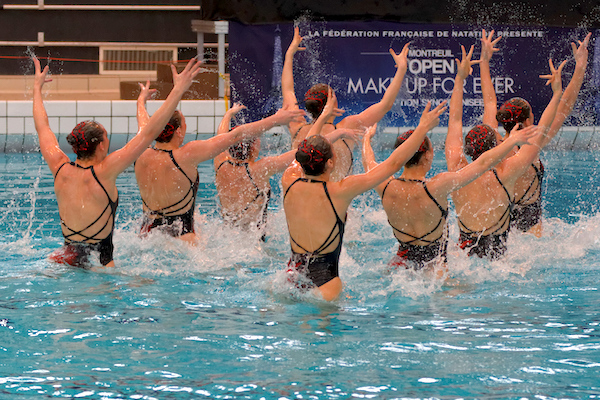All About Synchronized Swimming
Synchronized swimming, along with rhythmic gymnastics, are the misunderstood teenager of the Summer Olympics. Hidden in plain sight beneath an aesthetic obsessed exterior is a strikingly difficult and physically demanding sport, worthy of olympic-sized respect.
How Does Synchronized Swimming Work?
Teams or pairs of swimmers dive into a pool and, without touching the bottom, perform two to four minute routines. During that time, none of the swimmers are allowed to touch the bottom. The competition is split into two routines – a technical routine and a free routine. In the technical routine, certain required elements must be performed in a particular order. For example, one required element is a Fishtail, which is: “From a Front Layout Position, a Front Pike Position is assumed; one leg is lifted to a Fishtail Position, the second leg is lifted to a Vertical Position (ending is optional)” The free routine is, you guessed it, free of required elements. Routines are done to music, which is also pumped into the pool under water to help swimmers stay on tempo. The routines are scored by a panel of judges who give the performance a technical and artistic score.
Why do People Like Watching Synchronized Swimming?
I think there’s something innately fascinating and impressive about synchronization. Marching bands, geese flying in formation, the pattern of an industrial machine — all of these are mesmerizing in their own way. Synchronized swimming combines this allure with truly impressive athleticism. Try counting the seconds these athletes spend under water, without breathing, while contorting their body into all sorts of positions!
Check out some highlights from the 2012 Olympics:
What are the different events?
There are only two synchronized swimming events – the women’s duet and the women’s team competition.
How Dangerous is Synchronized Swimming?
Synchronized swimming is shockingly, surprisingly dangerous! Due to the arms race for tight formations, synchronized swimmers now regularly smash into each other as they transition from one element to another under water. All of these collisions add up and concussions are very common. A recent New York Times article on the topic suggested that somewhere between half and all of synchronized swimmers will suffer a concussion. Furthermore, “swimmers are sometimes slow to recognize they have a concussion because many of the symptoms, like dizziness and blurred vision, can be caused by swimming upside down and holding their breath for long periods.” WHOA!! This sport is dangerous!
What’s the State of Gender Equality in Synchronized Swimming?
There are no men in synchronized swimming! Make what you want of that fact, I guess. You could see it as a rare sport that favors women or as a cynical instantiation of misogynist culture that restricts women to superficially beautiful activities and therefore minimizes the achievement of world class synchronized swimming or even as unacceptable discrimination against men.
Links!
Bookmark the full Olympics schedule from NBC. Synchronized Swimming is from Sunday, August 14 to Friday, August 19.
Read more about Synchronized Swimming on the official Rio Olympics site.

